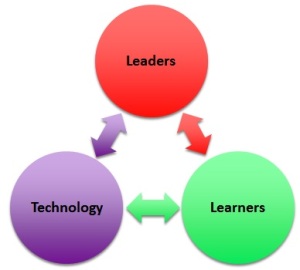One of the most significant advantages a learning culture offers is the ability to be constantly managing, maintaining and updating knowledge in their digital repositories or knowledgebases. In a learning culture the traditional corporate silos are no longer a barrier to learning. Information is openly shared between R&D and manufacturing, manufacturing and marketing, marketing and administration, administration and sales, and so on.
The minds of people working both inside and outside the organization contain valuable information— whether they are C-level executives or clients/customers or vendors and partners. When all three knowledge streams are in play – learners, leaders, technology – and aligned with the goals of the corporation, they create a sort of “super intelligence” for the organization in which the sum total of knowledge is continuously shared, updated, reviewed, revised and shared again.
A learning culture always operates as a closed loop with information moving in both directions between these three key contributors. The learning can pass from learners to leaders, learners to learners, or from the enabling technology to learners — or in the opposite direction. This is why we call it a “bi-directional model.”
The knowledge and skills held by the individuals who make up three knowledge streams can reside in the digital repository, which is easily updated and maintained. The benefits to both the individual and the organization are many. For example, when someone discovers a better, faster or more cost-effective way of doing something, the specific information can easily be added to or updated in the repository, making it readily accessible as needed.
When learning is at the heart of a corporation’s culture and a key driver for its success, specific, up-to-date knowledge and information is available from multiple channels whenever and wherever learners need that knowledge to do their jobs. As an equation, a learning culture would look like his: Leaders + Learners + Technology = Learning Culture.
Becoming a Learning Culture is Critical to Your Corporation’s Future
Why has it become critical for corporations to make the transition from a training culture to a learning culture, and what are some of the major considerations? When we first started studying organizational learning, it conformed to the then-prevailing schoolroom “push “model adopted for the workplace.
Corporations spent a large amount of time and money to produce training programs that were delivered to employees in a classroom. Learners had to be on-site, sitting in a room with a specified number of other people who had also been told to attend the training. Each session began and ended at a specific time. Each attendee received the same materials and information at the same time
This model worked because corporations were centralized and standardized. Because people worked in the same time zone and physical location, on the same days of the week and for the same hours of the day, having people attend learning and training events together was efficient. The business and economic environments changed slowly, so products and services had a longer shelf-life and did not need continuous updating. Corporations had the luxury of long development schedules and generous budgets for developing training about how to manufacture, sell or fix products.
That is no longer the world in which we operate.

